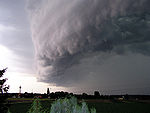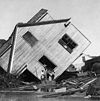Portal:Weather
The weather portal
Weatheris the state of theatmosphere,describing for example the degree to which it is hot or cold, wet or dry, calm or stormy, clear orcloudy.OnEarth,most weather phenomena occur in the lowest layer of the planet'satmosphere,thetroposphere,just below thestratosphere.Weather refers to day-to-day temperature,precipitation,and other atmospheric conditions, whereasclimateis the term for the averaging of atmospheric conditions over longer periods of time. When used without qualification, "weather" is generally understood to mean the weather of Earth.
Weather is driven byair pressure,temperature,andmoisturedifferences between one place and another. These differences can occur due to theSun's angleat any particular spot, which varies withlatitude.The strong temperature contrast between polar and tropical air gives rise to the largest scaleatmospheric circulations:theHadley cell,theFerrel cell,thepolar cell,and thejet stream.Weather systems in themiddle latitudes,such asextratropical cyclones,are caused by instabilities of the jet streamflow. Because Earth'saxis is tiltedrelative to itsorbital plane(called theecliptic),sunlightis incident atdifferent anglesat different times of the year. On Earth's surface, temperatures usually range ±40 °C (−40 °F to 104 °F) annually. Over thousands of years, changes in Earth'sorbitcan affect the amount and distribution ofsolar energyreceived by Earth, thus influencing long-term climate and globalclimate change.
Surface temperature differences in turn cause pressure differences. Higher altitudes are cooler than lower altitudes, as most atmospheric heating is due to contact with the Earth's surface while radiative losses to space are mostly constant.Weather forecastingis the application of science and technology to predict the state of theatmospherefor a future time and a given location. Earth's weather system is achaotic system;as a result, small changes to one part of the system can grow to have large effects on the system as a whole. Human attempts tocontrol the weatherhave occurred throughout history, and there is evidence thathuman activitiessuch as agriculture and industry have modified weather patterns.
Studying how the weather works on other planets has been helpful in understanding how weather works on Earth. A famous landmark in theSolar System,Jupiter'sGreat Red Spot,is ananticyclonic stormknown to have existed for at least 300 years. However, the weather is not limited to planetary bodies. Astar's coronais constantly being lost to space, creating what is essentially a very thin atmosphere throughout the Solar System. The movement of mass ejected from theSunis known as thesolar wind.(Full article...)
Selected article
Thewater cycle,also known as thehydrologic cycle,describes the continuous movement ofwateron, above, and below the surface of theEarth.Since the water cycle is truly a "cycle," there is no beginning or end. Water can change states amongliquid,vapor,andiceat various places in the water cycle, with these processes happening in the blink of an eye or over millions of years. Although the balance of water on Earth remains fairly constant over time, individual water molecules can come and go in a hurry.

Recently selected articles:Global warming,1999 Sydney hailstorm,More...
Did you know(auto-generated)-

- ... thatEric Bergerwrote about weather for theHouston Chronicleeven before he became a certified meteorologist?
- ... thatan attempted British-Norwegian attackon theGerman battleshipTirpitzwas abandoned after twoChariot manned torpedoeswere lost due to bad weather?
- ... that Japanese actor Kouhei Higuchi prepared for his role on the television drama adaptation ofMy Personal Weathermanby learning from a weather forecaster?
- ... thatweather whiplashis the phenomenon of rapid swings between extremes of weather conditions?
- ... thatthe weather forecastforHD 189733 bis "Westerly winds at 2000 m/s, with molten glass showers"?
- ... that in the 1980s, "Sherman Bonner, The Human Thermometer" presented the weather onan Arkansas TV station?
Selected image

Adust stormis ameteorological phenomenonwhere strong winds lift loosedustfromaridandsemi-aridregions, often transporting the particles long distances. These storms can continue hundreds of miles from their source, and can have drastic effects on human health, transportation, and society in general. This storm occurred in May 2005 over theRed Sea.
Recently selected pictures:Parallax,Global snow cover,Snow flakes,More...
More did you know...
...that theFlying riveris the name given to the transport ofwater vaporfrom theAmazon rainforestto southernBrazil?
...thathurricane shuttersare required for all homes inFloridaunless impact-resistant glass is used?
...that theJoint Institute for Marine and Atmospheric Researchis a combined weather and ocean research institute with the cooperation of theOffice of Oceanic and Atmospheric Researchand theUniversity of Hawaiʻi?
...that theSS Central Americawas sunk by ahurricanewhile carrying more than 30,000 pounds (13,600 kg) of gold, contributing to thePanic of 1857?
...that ahurricane force wind warningis issued by theUnited StatesNational Weather Servicefor storms that are nottropical cyclonesbut are expected to produce hurricane-force winds (65 knots (75 mph; 120 km/h) or higher)?
...that theAutomated Tropical Cyclone Forecasting Systemis a software package fortropical cycloneforecastingdeveloped in 1988 that is still used today bymeteorologistsin various branches of theUS Government?
Recent and ongoing weather
- Wikinews weather portal
- March 26,2021:Tropical moisture ceases to cause severe floods in South East Australia
- February 19,2021:Winter storms hammer Texas, fatalities reported
- December 28,2021:Typhoon Phanfone strikes Philippines
- February 1,2022:Deadly floods in Brazil after heavy rainfall
- April 15,2022:South African floods kill at least 300 people
- Weather of 2024
- 2024 Atlantic hurricane season
- 2020–21 North American winter
- 2024 Pacific typhoon season
- Tornadoes of 2024
This week in weather history...
July 14
1977:The first of theHimawariseries ofweather satellites,operated by theJapan Meteorological Agency,was launched fromCape Canaveral Air Force Station.
July 15
2001:TheSouth African Weather Servicewas formed.
July 16
1904:Adestructive tornadostruckChappaqua, New York,killing two people.
July 17
2013:Tropical Storm Cimaronformed nearCalayan, Cagayan,Philippines.Alightningstrike from the storm inIlocos Surkilled two people.
July 18
1996:AnF5 tornadostruck the village ofOakfield, Wisconsin.
July 19
1983:Aderecho,which moved along a path parallel toInterstate 94fromMinnesotatoIllinois,knocked outpowerto 250,000 people and injured at least 34.
July 20
2007:Severe floodingin theUnited Kingdompeaked as a storm system dropped as much as 120 millimeters (4.7 in) of rain on southernEngland.
Selected biography
Christophorus Henricus Diedericus Buys Ballot(Dutch pronunciation:[ˈbœysbaːˈlɔt];October 10, 1817 – February 3, 1890) was a Dutchchemistandmeteorologistafter whomBuys Ballot's lawand the Buys Ballot table are named. He was first chairman of theInternational Meteorological Organization,the organization that would become theWorld Meteorological Organization.(Full article...)
Previously selected biographies:Sir William Napier Shaw,Johannes Peter Letzmann,More...
Related portals
Quality content
Other candidates:
- Featured Article Review:2005 Atlantic hurricane season(Discussion)
- Featured List Removal Candidate:List of storms in the 2005 Atlantic hurricane season(Discussion)
Subcategories
WikiProjects
The scope ofWikiProject Weatheris to have a single location for all weather-related articles on Wikipedia.
WikiProject Meteorologyis a collaborative effort by dozens of Wikipedians to improve the quality ofmeteorology- andweather-related articles. If you would like to help, visit theproject talk page,and see what needs doing.
WikiProject Severe weatheris a similar project specific to articles aboutsevere weather.Their talk page is locatedhere.
WikiProject Tropical cyclonesis a daughter project of WikiProject meteorology. The dozens of semi-active members and several full-time members focus on improving Wikipedia's coverage oftropical cyclones.
WikiProject Non-tropical stormsis a collaborative project to improve articles related to winter storms, wind storms, and extratropical cyclones.
Wikipedia is a fully collaborative effort by volunteers. So if you see something you think you can improve,be boldand get to editing! We appreciate any help you can provide!
Associated Wikimedia
The followingWikimedia Foundationsister projects provide more on this subject:
-
Commons
Free media repository -
Wikibooks
Free textbooks and manuals -
Wikidata
Free knowledge base -
Wikinews
Free-content news -
Wikiquote
Collection of quotations -
Wikisource
Free-content library -
Wikiversity
Free learning tools -
Wiktionary
Dictionary and thesaurus

































